Business Environment Analysis of Marks and Spencer (M&S)
VerifiedAdded on 2023/01/11
|17
|5354
|43
Report
AI Summary
This report provides a detailed analysis of the business environment, focusing on Marks and Spencer (M&S). It begins by exploring different types of organizations, their purposes, and legal structures, including public, private, and voluntary sectors, and relevant legislation such as the Partnership Act 1890 and Companies Act 2006. The report then examines the size and scope of various organizations (micro, small, medium, and large), relating them to M&S's PLC status. It proceeds to analyze the interrelationship between organizational functions like HRM, marketing, IT, production, finance, and R&D, highlighting their importance for achieving business objectives. The report further investigates the macro environment's impact on M&S using PESTEL analysis, covering political, economic, social, technological, environmental, and legal factors. Finally, it conducts an internal analysis of M&S, assessing its strengths, weaknesses, and how they relate to the external macro environment. The report concludes with an evaluation of M&S's overall business strategy and performance.

Business and Business
Environment
Environment
Paraphrase This Document
Need a fresh take? Get an instant paraphrase of this document with our AI Paraphraser
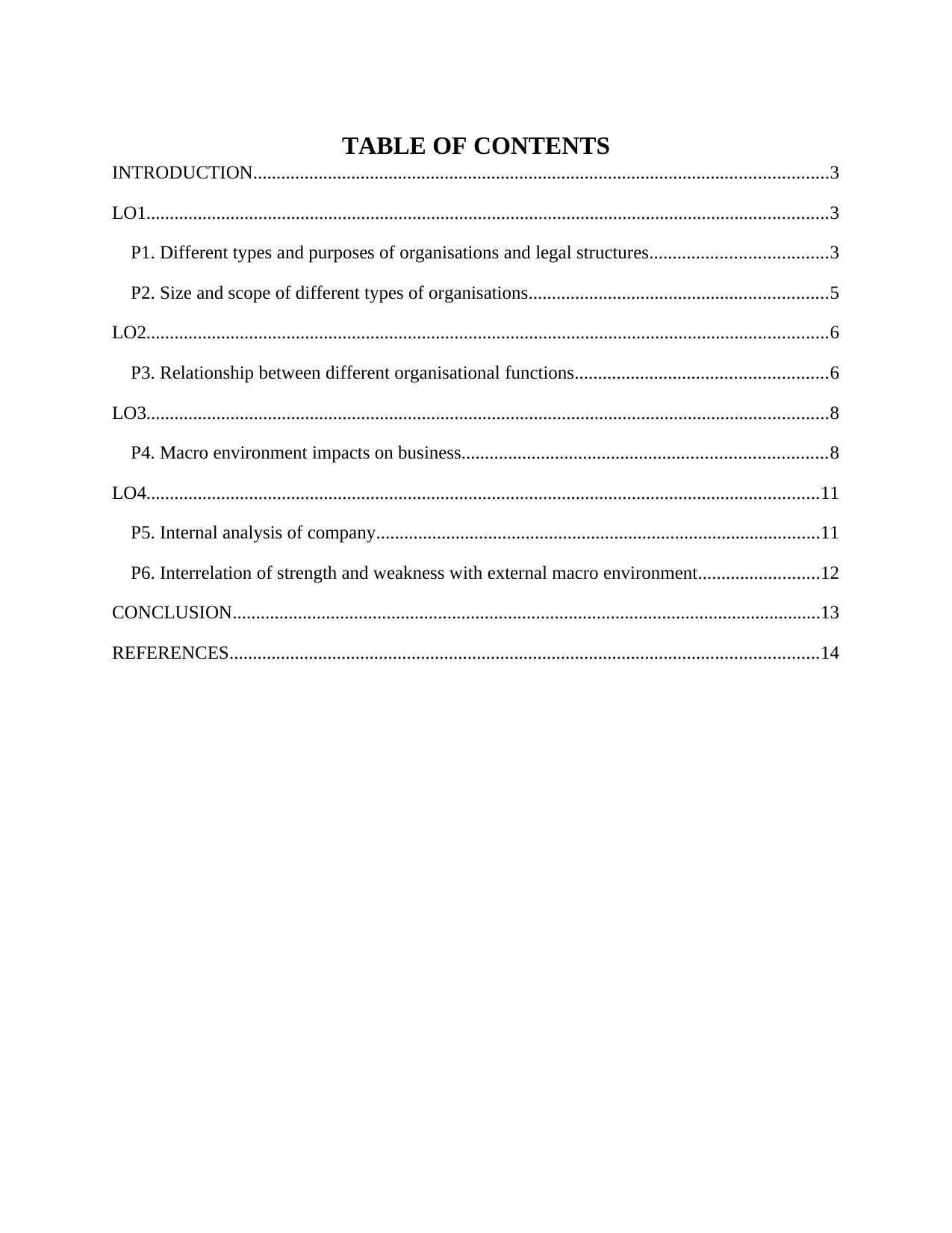
TABLE OF CONTENTS
INTRODUCTION...........................................................................................................................3
LO1..................................................................................................................................................3
P1. Different types and purposes of organisations and legal structures......................................3
P2. Size and scope of different types of organisations................................................................5
LO2..................................................................................................................................................6
P3. Relationship between different organisational functions......................................................6
LO3..................................................................................................................................................8
P4. Macro environment impacts on business..............................................................................8
LO4................................................................................................................................................11
P5. Internal analysis of company...............................................................................................11
P6. Interrelation of strength and weakness with external macro environment..........................12
CONCLUSION..............................................................................................................................13
REFERENCES..............................................................................................................................14
INTRODUCTION...........................................................................................................................3
LO1..................................................................................................................................................3
P1. Different types and purposes of organisations and legal structures......................................3
P2. Size and scope of different types of organisations................................................................5
LO2..................................................................................................................................................6
P3. Relationship between different organisational functions......................................................6
LO3..................................................................................................................................................8
P4. Macro environment impacts on business..............................................................................8
LO4................................................................................................................................................11
P5. Internal analysis of company...............................................................................................11
P6. Interrelation of strength and weakness with external macro environment..........................12
CONCLUSION..............................................................................................................................13
REFERENCES..............................................................................................................................14
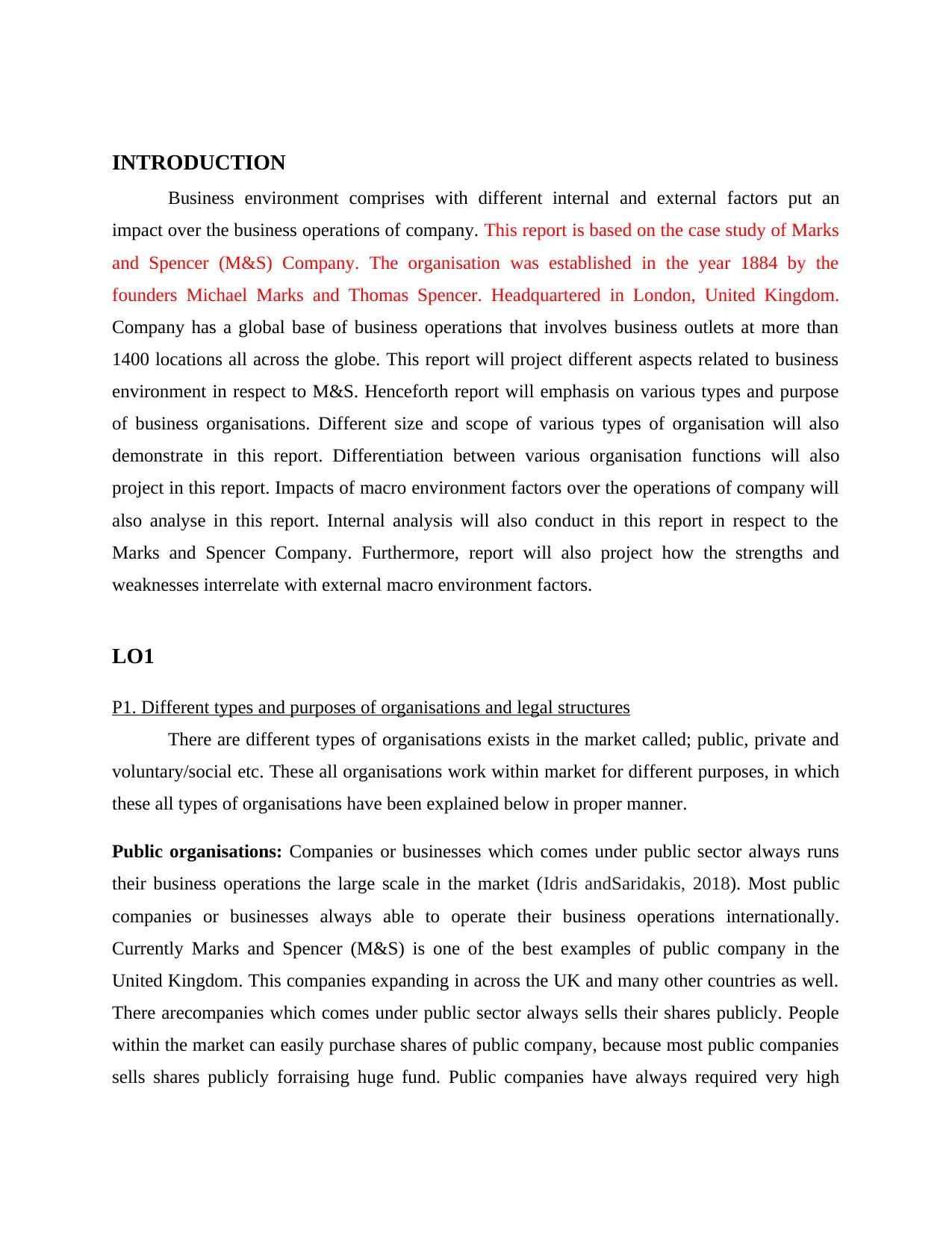
INTRODUCTION
Business environment comprises with different internal and external factors put an
impact over the business operations of company. This report is based on the case study of Marks
and Spencer (M&S) Company. The organisation was established in the year 1884 by the
founders Michael Marks and Thomas Spencer. Headquartered in London, United Kingdom.
Company has a global base of business operations that involves business outlets at more than
1400 locations all across the globe. This report will project different aspects related to business
environment in respect to M&S. Henceforth report will emphasis on various types and purpose
of business organisations. Different size and scope of various types of organisation will also
demonstrate in this report. Differentiation between various organisation functions will also
project in this report. Impacts of macro environment factors over the operations of company will
also analyse in this report. Internal analysis will also conduct in this report in respect to the
Marks and Spencer Company. Furthermore, report will also project how the strengths and
weaknesses interrelate with external macro environment factors.
LO1
P1. Different types and purposes of organisations and legal structures
There are different types of organisations exists in the market called; public, private and
voluntary/social etc. These all organisations work within market for different purposes, in which
these all types of organisations have been explained below in proper manner.
Public organisations: Companies or businesses which comes under public sector always runs
their business operations the large scale in the market (Idris andSaridakis, 2018). Most public
companies or businesses always able to operate their business operations internationally.
Currently Marks and Spencer (M&S) is one of the best examples of public company in the
United Kingdom. This companies expanding in across the UK and many other countries as well.
There arecompanies which comes under public sector always sells their shares publicly. People
within the market can easily purchase shares of public company, because most public companies
sells shares publicly forraising huge fund. Public companies have always required very high
Business environment comprises with different internal and external factors put an
impact over the business operations of company. This report is based on the case study of Marks
and Spencer (M&S) Company. The organisation was established in the year 1884 by the
founders Michael Marks and Thomas Spencer. Headquartered in London, United Kingdom.
Company has a global base of business operations that involves business outlets at more than
1400 locations all across the globe. This report will project different aspects related to business
environment in respect to M&S. Henceforth report will emphasis on various types and purpose
of business organisations. Different size and scope of various types of organisation will also
demonstrate in this report. Differentiation between various organisation functions will also
project in this report. Impacts of macro environment factors over the operations of company will
also analyse in this report. Internal analysis will also conduct in this report in respect to the
Marks and Spencer Company. Furthermore, report will also project how the strengths and
weaknesses interrelate with external macro environment factors.
LO1
P1. Different types and purposes of organisations and legal structures
There are different types of organisations exists in the market called; public, private and
voluntary/social etc. These all organisations work within market for different purposes, in which
these all types of organisations have been explained below in proper manner.
Public organisations: Companies or businesses which comes under public sector always runs
their business operations the large scale in the market (Idris andSaridakis, 2018). Most public
companies or businesses always able to operate their business operations internationally.
Currently Marks and Spencer (M&S) is one of the best examples of public company in the
United Kingdom. This companies expanding in across the UK and many other countries as well.
There arecompanies which comes under public sector always sells their shares publicly. People
within the market can easily purchase shares of public company, because most public companies
sells shares publicly forraising huge fund. Public companies have always required very high
⊘ This is a preview!⊘
Do you want full access?
Subscribe today to unlock all pages.

Trusted by 1+ million students worldwide

technology in their daily operations, because these companies or organisations run their
operations at the large scale in the market.
Privateorganisations:Private organisations or companies always have something less scope in
the comparison of public companies. Most private companies run their business operations at the
regional and national level (Green and Morton, 2017). Currently only few private companies are
existing in the United Kingdom which run their operations at the international level. There are
Iceland foods ltd.is the best example of private organisation in the UK. Companieswithin private
sector not sells their shares publicly, because many times owners and upper management of
private companiesoffers shares to only their close people, like; friends and family members
etc.Private companiesalso always need to implement technology, but not high-fi technology as
public organisations or companies, because a private company always run its operations only in
some selected zones, that’s why it can run its operations with common or ordinary technology as
well.
Voluntary/socialorganisations:A voluntary organisation always runs its operations and
activities at the very low scale within the market. Voluntary sector organisations expand their
services on the basis of their cash or fund inflow (Usaiand et.al., 2018). For example; when
voluntary or social organisations achieves high fund through charity and donation, thenthey can
easily expand their services at the international level. Social organisations always have zero
involvement of shareholders, because social organisations not workto earn high profit. These
organisations raise fund only by charity and donation. Most social or voluntary organisations not
uses high-fi technology, because these organisations have no need for producing various
products and services. Voluntary organisationsuse only few common technological tools and
gadgets. For example; personal computer, calculator,smart phone etc.Currently the children’s
society is the best example of voluntary or social organisation. it is a popular charity organisation
in the United Kingdom.
Legal Structure
All types of organisations ae highly required different legal and ethical considerations
which has passed by government of the United Kingdom. There are some major legal and ethical
terms has been discussed below which every organisation needs to follows in its daily operations
operations at the large scale in the market.
Privateorganisations:Private organisations or companies always have something less scope in
the comparison of public companies. Most private companies run their business operations at the
regional and national level (Green and Morton, 2017). Currently only few private companies are
existing in the United Kingdom which run their operations at the international level. There are
Iceland foods ltd.is the best example of private organisation in the UK. Companieswithin private
sector not sells their shares publicly, because many times owners and upper management of
private companiesoffers shares to only their close people, like; friends and family members
etc.Private companiesalso always need to implement technology, but not high-fi technology as
public organisations or companies, because a private company always run its operations only in
some selected zones, that’s why it can run its operations with common or ordinary technology as
well.
Voluntary/socialorganisations:A voluntary organisation always runs its operations and
activities at the very low scale within the market. Voluntary sector organisations expand their
services on the basis of their cash or fund inflow (Usaiand et.al., 2018). For example; when
voluntary or social organisations achieves high fund through charity and donation, thenthey can
easily expand their services at the international level. Social organisations always have zero
involvement of shareholders, because social organisations not workto earn high profit. These
organisations raise fund only by charity and donation. Most social or voluntary organisations not
uses high-fi technology, because these organisations have no need for producing various
products and services. Voluntary organisationsuse only few common technological tools and
gadgets. For example; personal computer, calculator,smart phone etc.Currently the children’s
society is the best example of voluntary or social organisation. it is a popular charity organisation
in the United Kingdom.
Legal Structure
All types of organisations ae highly required different legal and ethical considerations
which has passed by government of the United Kingdom. There are some major legal and ethical
terms has been discussed below which every organisation needs to follows in its daily operations
Paraphrase This Document
Need a fresh take? Get an instant paraphrase of this document with our AI Paraphraser
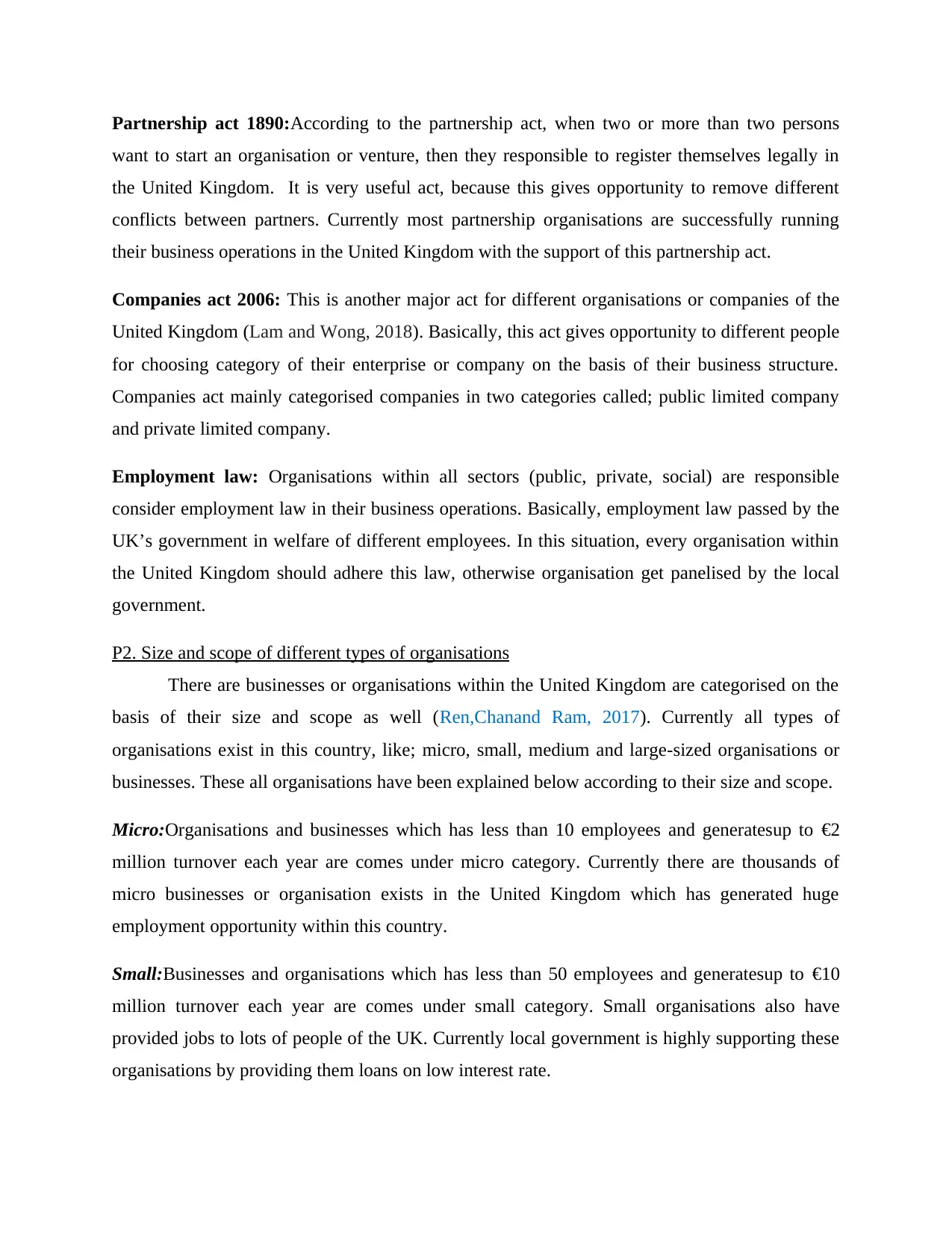
Partnership act 1890:According to the partnership act, when two or more than two persons
want to start an organisation or venture, then they responsible to register themselves legally in
the United Kingdom. It is very useful act, because this gives opportunity to remove different
conflicts between partners. Currently most partnership organisations are successfully running
their business operations in the United Kingdom with the support of this partnership act.
Companies act 2006: This is another major act for different organisations or companies of the
United Kingdom (Lam and Wong, 2018). Basically, this act gives opportunity to different people
for choosing category of their enterprise or company on the basis of their business structure.
Companies act mainly categorised companies in two categories called; public limited company
and private limited company.
Employment law: Organisations within all sectors (public, private, social) are responsible
consider employment law in their business operations. Basically, employment law passed by the
UK’s government in welfare of different employees. In this situation, every organisation within
the United Kingdom should adhere this law, otherwise organisation get panelised by the local
government.
P2. Size and scope of different types of organisations
There are businesses or organisations within the United Kingdom are categorised on the
basis of their size and scope as well (Ren,Chanand Ram, 2017). Currently all types of
organisations exist in this country, like; micro, small, medium and large-sized organisations or
businesses. These all organisations have been explained below according to their size and scope.
Micro:Organisations and businesses which has less than 10 employees and generatesup to €2
million turnover each year are comes under micro category. Currently there are thousands of
micro businesses or organisation exists in the United Kingdom which has generated huge
employment opportunity within this country.
Small:Businesses and organisations which has less than 50 employees and generatesup to €10
million turnover each year are comes under small category. Small organisations also have
provided jobs to lots of people of the UK. Currently local government is highly supporting these
organisations by providing them loans on low interest rate.
want to start an organisation or venture, then they responsible to register themselves legally in
the United Kingdom. It is very useful act, because this gives opportunity to remove different
conflicts between partners. Currently most partnership organisations are successfully running
their business operations in the United Kingdom with the support of this partnership act.
Companies act 2006: This is another major act for different organisations or companies of the
United Kingdom (Lam and Wong, 2018). Basically, this act gives opportunity to different people
for choosing category of their enterprise or company on the basis of their business structure.
Companies act mainly categorised companies in two categories called; public limited company
and private limited company.
Employment law: Organisations within all sectors (public, private, social) are responsible
consider employment law in their business operations. Basically, employment law passed by the
UK’s government in welfare of different employees. In this situation, every organisation within
the United Kingdom should adhere this law, otherwise organisation get panelised by the local
government.
P2. Size and scope of different types of organisations
There are businesses or organisations within the United Kingdom are categorised on the
basis of their size and scope as well (Ren,Chanand Ram, 2017). Currently all types of
organisations exist in this country, like; micro, small, medium and large-sized organisations or
businesses. These all organisations have been explained below according to their size and scope.
Micro:Organisations and businesses which has less than 10 employees and generatesup to €2
million turnover each year are comes under micro category. Currently there are thousands of
micro businesses or organisation exists in the United Kingdom which has generated huge
employment opportunity within this country.
Small:Businesses and organisations which has less than 50 employees and generatesup to €10
million turnover each year are comes under small category. Small organisations also have
provided jobs to lots of people of the UK. Currently local government is highly supporting these
organisations by providing them loans on low interest rate.
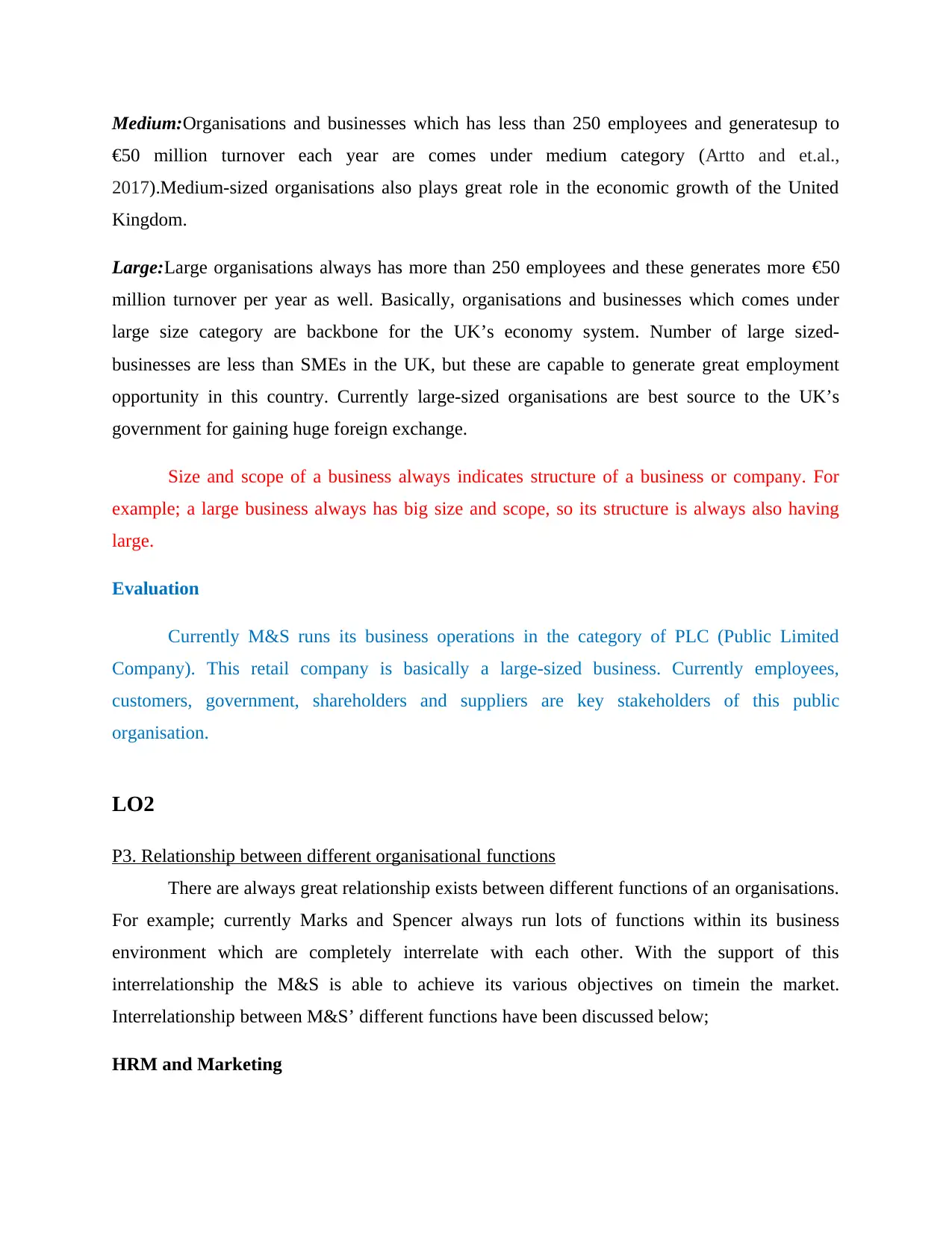
Medium:Organisations and businesses which has less than 250 employees and generatesup to
€50 million turnover each year are comes under medium category (Artto and et.al.,
2017).Medium-sized organisations also plays great role in the economic growth of the United
Kingdom.
Large:Large organisations always has more than 250 employees and these generates more €50
million turnover per year as well. Basically, organisations and businesses which comes under
large size category are backbone for the UK’s economy system. Number of large sized-
businesses are less than SMEs in the UK, but these are capable to generate great employment
opportunity in this country. Currently large-sized organisations are best source to the UK’s
government for gaining huge foreign exchange.
Size and scope of a business always indicates structure of a business or company. For
example; a large business always has big size and scope, so its structure is always also having
large.
Evaluation
Currently M&S runs its business operations in the category of PLC (Public Limited
Company). This retail company is basically a large-sized business. Currently employees,
customers, government, shareholders and suppliers are key stakeholders of this public
organisation.
LO2
P3. Relationship between different organisational functions
There are always great relationship exists between different functions of an organisations.
For example; currently Marks and Spencer always run lots of functions within its business
environment which are completely interrelate with each other. With the support of this
interrelationship the M&S is able to achieve its various objectives on timein the market.
Interrelationship between M&S’ different functions have been discussed below;
HRM and Marketing
€50 million turnover each year are comes under medium category (Artto and et.al.,
2017).Medium-sized organisations also plays great role in the economic growth of the United
Kingdom.
Large:Large organisations always has more than 250 employees and these generates more €50
million turnover per year as well. Basically, organisations and businesses which comes under
large size category are backbone for the UK’s economy system. Number of large sized-
businesses are less than SMEs in the UK, but these are capable to generate great employment
opportunity in this country. Currently large-sized organisations are best source to the UK’s
government for gaining huge foreign exchange.
Size and scope of a business always indicates structure of a business or company. For
example; a large business always has big size and scope, so its structure is always also having
large.
Evaluation
Currently M&S runs its business operations in the category of PLC (Public Limited
Company). This retail company is basically a large-sized business. Currently employees,
customers, government, shareholders and suppliers are key stakeholders of this public
organisation.
LO2
P3. Relationship between different organisational functions
There are always great relationship exists between different functions of an organisations.
For example; currently Marks and Spencer always run lots of functions within its business
environment which are completely interrelate with each other. With the support of this
interrelationship the M&S is able to achieve its various objectives on timein the market.
Interrelationship between M&S’ different functions have been discussed below;
HRM and Marketing
⊘ This is a preview!⊘
Do you want full access?
Subscribe today to unlock all pages.

Trusted by 1+ million students worldwide
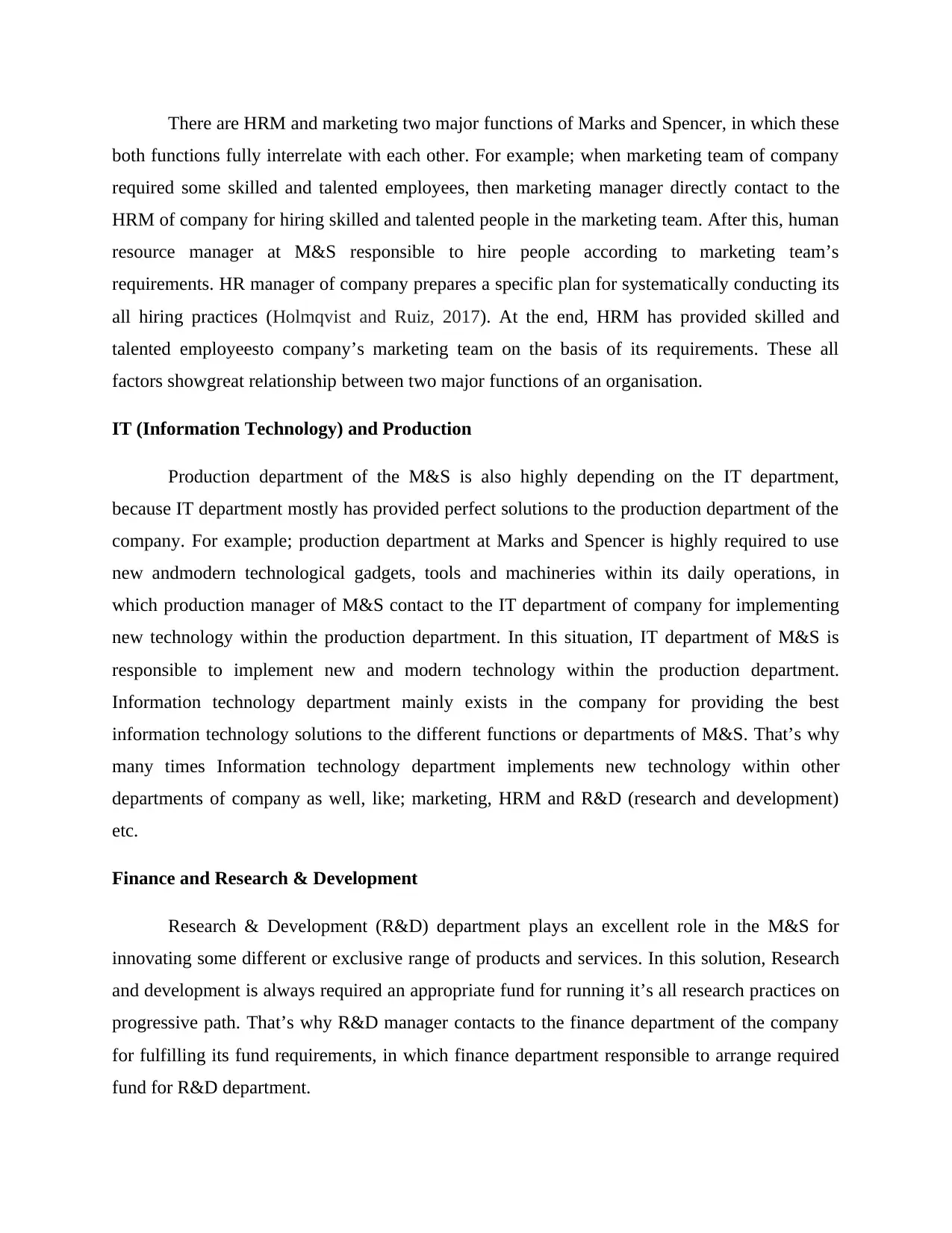
There are HRM and marketing two major functions of Marks and Spencer, in which these
both functions fully interrelate with each other. For example; when marketing team of company
required some skilled and talented employees, then marketing manager directly contact to the
HRM of company for hiring skilled and talented people in the marketing team. After this, human
resource manager at M&S responsible to hire people according to marketing team’s
requirements. HR manager of company prepares a specific plan for systematically conducting its
all hiring practices (Holmqvist and Ruiz, 2017). At the end, HRM has provided skilled and
talented employeesto company’s marketing team on the basis of its requirements. These all
factors showgreat relationship between two major functions of an organisation.
IT (Information Technology) and Production
Production department of the M&S is also highly depending on the IT department,
because IT department mostly has provided perfect solutions to the production department of the
company. For example; production department at Marks and Spencer is highly required to use
new andmodern technological gadgets, tools and machineries within its daily operations, in
which production manager of M&S contact to the IT department of company for implementing
new technology within the production department. In this situation, IT department of M&S is
responsible to implement new and modern technology within the production department.
Information technology department mainly exists in the company for providing the best
information technology solutions to the different functions or departments of M&S. That’s why
many times Information technology department implements new technology within other
departments of company as well, like; marketing, HRM and R&D (research and development)
etc.
Finance and Research & Development
Research & Development (R&D) department plays an excellent role in the M&S for
innovating some different or exclusive range of products and services. In this solution, Research
and development is always required an appropriate fund for running it’s all research practices on
progressive path. That’s why R&D manager contacts to the finance department of the company
for fulfilling its fund requirements, in which finance department responsible to arrange required
fund for R&D department.
both functions fully interrelate with each other. For example; when marketing team of company
required some skilled and talented employees, then marketing manager directly contact to the
HRM of company for hiring skilled and talented people in the marketing team. After this, human
resource manager at M&S responsible to hire people according to marketing team’s
requirements. HR manager of company prepares a specific plan for systematically conducting its
all hiring practices (Holmqvist and Ruiz, 2017). At the end, HRM has provided skilled and
talented employeesto company’s marketing team on the basis of its requirements. These all
factors showgreat relationship between two major functions of an organisation.
IT (Information Technology) and Production
Production department of the M&S is also highly depending on the IT department,
because IT department mostly has provided perfect solutions to the production department of the
company. For example; production department at Marks and Spencer is highly required to use
new andmodern technological gadgets, tools and machineries within its daily operations, in
which production manager of M&S contact to the IT department of company for implementing
new technology within the production department. In this situation, IT department of M&S is
responsible to implement new and modern technology within the production department.
Information technology department mainly exists in the company for providing the best
information technology solutions to the different functions or departments of M&S. That’s why
many times Information technology department implements new technology within other
departments of company as well, like; marketing, HRM and R&D (research and development)
etc.
Finance and Research & Development
Research & Development (R&D) department plays an excellent role in the M&S for
innovating some different or exclusive range of products and services. In this solution, Research
and development is always required an appropriate fund for running it’s all research practices on
progressive path. That’s why R&D manager contacts to the finance department of the company
for fulfilling its fund requirements, in which finance department responsible to arrange required
fund for R&D department.
Paraphrase This Document
Need a fresh take? Get an instant paraphrase of this document with our AI Paraphraser
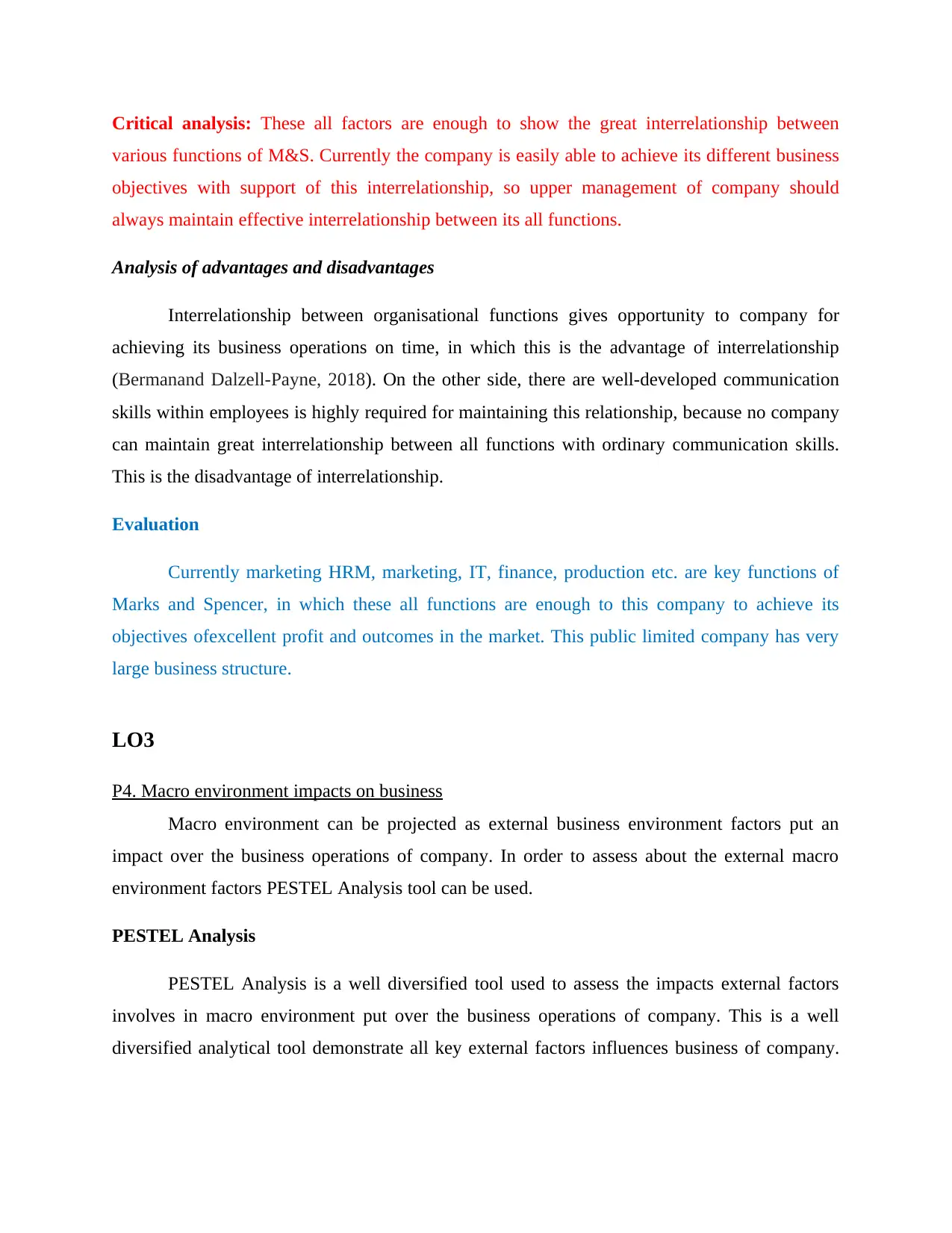
Critical analysis: These all factors are enough to show the great interrelationship between
various functions of M&S. Currently the company is easily able to achieve its different business
objectives with support of this interrelationship, so upper management of company should
always maintain effective interrelationship between its all functions.
Analysis of advantages and disadvantages
Interrelationship between organisational functions gives opportunity to company for
achieving its business operations on time, in which this is the advantage of interrelationship
(Bermanand Dalzell-Payne, 2018). On the other side, there are well-developed communication
skills within employees is highly required for maintaining this relationship, because no company
can maintain great interrelationship between all functions with ordinary communication skills.
This is the disadvantage of interrelationship.
Evaluation
Currently marketing HRM, marketing, IT, finance, production etc. are key functions of
Marks and Spencer, in which these all functions are enough to this company to achieve its
objectives ofexcellent profit and outcomes in the market. This public limited company has very
large business structure.
LO3
P4. Macro environment impacts on business
Macro environment can be projected as external business environment factors put an
impact over the business operations of company. In order to assess about the external macro
environment factors PESTEL Analysis tool can be used.
PESTEL Analysis
PESTEL Analysis is a well diversified tool used to assess the impacts external factors
involves in macro environment put over the business operations of company. This is a well
diversified analytical tool demonstrate all key external factors influences business of company.
various functions of M&S. Currently the company is easily able to achieve its different business
objectives with support of this interrelationship, so upper management of company should
always maintain effective interrelationship between its all functions.
Analysis of advantages and disadvantages
Interrelationship between organisational functions gives opportunity to company for
achieving its business operations on time, in which this is the advantage of interrelationship
(Bermanand Dalzell-Payne, 2018). On the other side, there are well-developed communication
skills within employees is highly required for maintaining this relationship, because no company
can maintain great interrelationship between all functions with ordinary communication skills.
This is the disadvantage of interrelationship.
Evaluation
Currently marketing HRM, marketing, IT, finance, production etc. are key functions of
Marks and Spencer, in which these all functions are enough to this company to achieve its
objectives ofexcellent profit and outcomes in the market. This public limited company has very
large business structure.
LO3
P4. Macro environment impacts on business
Macro environment can be projected as external business environment factors put an
impact over the business operations of company. In order to assess about the external macro
environment factors PESTEL Analysis tool can be used.
PESTEL Analysis
PESTEL Analysis is a well diversified tool used to assess the impacts external factors
involves in macro environment put over the business operations of company. This is a well
diversified analytical tool demonstrate all key external factors influences business of company.

This analysis tool comprises with factors like political, economical, social, technological,
environment and legal factors.
Political factor: Political factor involves political situation of the country. Marks and Spencer
Company is based in United Kingdom and carry the global base of business operations by owns
stores at more than 1400 locations all across the globe. So it can project that political situation at
global level influence the business of company. Political factor comprises with different policies
government frame towards the growth and development of corporate sector (Madonsela,
Mukwakungu and Mbohwa, 2017). Economic growth is a big aim governments all across the
globe carry which is directly associated with the growth and development of corporate sector.
Majority of governments all across the globe support the growth and development of corporate
sector which also droves them to form smooth policies to support corporate sector. Political
stability is also one of the major factor of macro environment part of the Political factor involve
in PESTEL Analysis. Stable political position allows governments to form long term policies and
strategies. It can be projected that political factor is among the key external business
environment factor influences the business of Marks and Spencer Company. All the wrong
decisions government make reduces the growth of company. Instability directly restricts the
growth chances of company.
Economic Factor: Economic factor demonstrate about the economic position of country.
Economic factor is among the key business environment factor influences the business of Marks
and Spencer Company. This factor of external business environment involves growth rate of
gross domestic products, currency exchange rate and many other factors. All such factors
directly influence over the prices of different retail products (Purnama and Subroto, 2016).
Inflation in the economises all across the globe also influences the business of company.
Inflation also resulted into price hike of all the retail products. Inflation restricts the purchasing
power of customers which also resulted into low sales turnover of company. It can be projected
that economic factor is among the aggressive business environment factor influence the business
and growth of the company.
Social Factor: Social factor is also among the key macro environment factor influence the
business of company. Social factor involves culture, values, ethics, believes of people, attitude of
society and many other factors that becomes part of the purchase decision of customers.
environment and legal factors.
Political factor: Political factor involves political situation of the country. Marks and Spencer
Company is based in United Kingdom and carry the global base of business operations by owns
stores at more than 1400 locations all across the globe. So it can project that political situation at
global level influence the business of company. Political factor comprises with different policies
government frame towards the growth and development of corporate sector (Madonsela,
Mukwakungu and Mbohwa, 2017). Economic growth is a big aim governments all across the
globe carry which is directly associated with the growth and development of corporate sector.
Majority of governments all across the globe support the growth and development of corporate
sector which also droves them to form smooth policies to support corporate sector. Political
stability is also one of the major factor of macro environment part of the Political factor involve
in PESTEL Analysis. Stable political position allows governments to form long term policies and
strategies. It can be projected that political factor is among the key external business
environment factor influences the business of Marks and Spencer Company. All the wrong
decisions government make reduces the growth of company. Instability directly restricts the
growth chances of company.
Economic Factor: Economic factor demonstrate about the economic position of country.
Economic factor is among the key business environment factor influences the business of Marks
and Spencer Company. This factor of external business environment involves growth rate of
gross domestic products, currency exchange rate and many other factors. All such factors
directly influence over the prices of different retail products (Purnama and Subroto, 2016).
Inflation in the economises all across the globe also influences the business of company.
Inflation also resulted into price hike of all the retail products. Inflation restricts the purchasing
power of customers which also resulted into low sales turnover of company. It can be projected
that economic factor is among the aggressive business environment factor influence the business
and growth of the company.
Social Factor: Social factor is also among the key macro environment factor influence the
business of company. Social factor involves culture, values, ethics, believes of people, attitude of
society and many other factors that becomes part of the purchase decision of customers.
⊘ This is a preview!⊘
Do you want full access?
Subscribe today to unlock all pages.

Trusted by 1+ million students worldwide
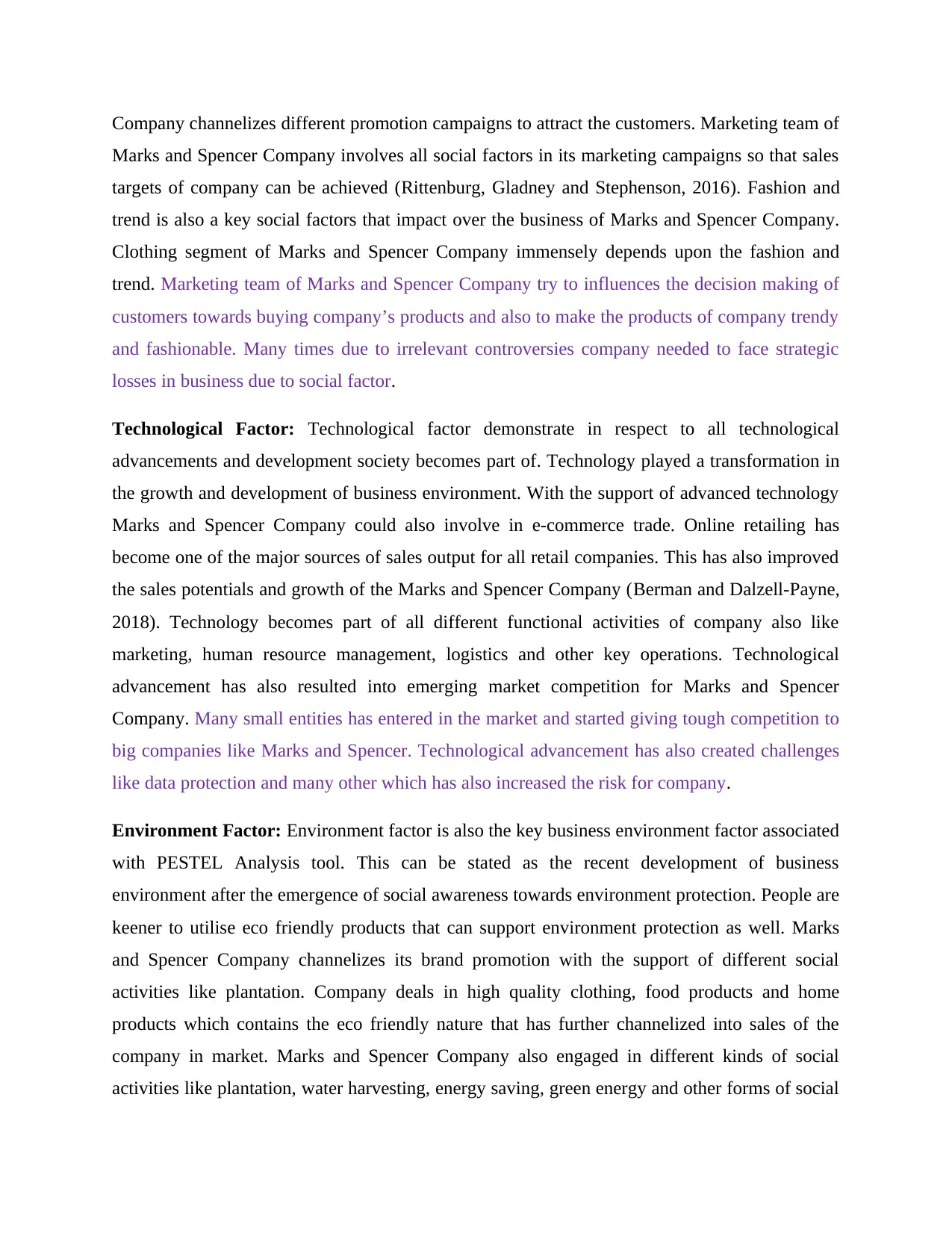
Company channelizes different promotion campaigns to attract the customers. Marketing team of
Marks and Spencer Company involves all social factors in its marketing campaigns so that sales
targets of company can be achieved (Rittenburg, Gladney and Stephenson, 2016). Fashion and
trend is also a key social factors that impact over the business of Marks and Spencer Company.
Clothing segment of Marks and Spencer Company immensely depends upon the fashion and
trend. Marketing team of Marks and Spencer Company try to influences the decision making of
customers towards buying company’s products and also to make the products of company trendy
and fashionable. Many times due to irrelevant controversies company needed to face strategic
losses in business due to social factor.
Technological Factor: Technological factor demonstrate in respect to all technological
advancements and development society becomes part of. Technology played a transformation in
the growth and development of business environment. With the support of advanced technology
Marks and Spencer Company could also involve in e-commerce trade. Online retailing has
become one of the major sources of sales output for all retail companies. This has also improved
the sales potentials and growth of the Marks and Spencer Company (Berman and Dalzell-Payne,
2018). Technology becomes part of all different functional activities of company also like
marketing, human resource management, logistics and other key operations. Technological
advancement has also resulted into emerging market competition for Marks and Spencer
Company. Many small entities has entered in the market and started giving tough competition to
big companies like Marks and Spencer. Technological advancement has also created challenges
like data protection and many other which has also increased the risk for company.
Environment Factor: Environment factor is also the key business environment factor associated
with PESTEL Analysis tool. This can be stated as the recent development of business
environment after the emergence of social awareness towards environment protection. People are
keener to utilise eco friendly products that can support environment protection as well. Marks
and Spencer Company channelizes its brand promotion with the support of different social
activities like plantation. Company deals in high quality clothing, food products and home
products which contains the eco friendly nature that has further channelized into sales of the
company in market. Marks and Spencer Company also engaged in different kinds of social
activities like plantation, water harvesting, energy saving, green energy and other forms of social
Marks and Spencer Company involves all social factors in its marketing campaigns so that sales
targets of company can be achieved (Rittenburg, Gladney and Stephenson, 2016). Fashion and
trend is also a key social factors that impact over the business of Marks and Spencer Company.
Clothing segment of Marks and Spencer Company immensely depends upon the fashion and
trend. Marketing team of Marks and Spencer Company try to influences the decision making of
customers towards buying company’s products and also to make the products of company trendy
and fashionable. Many times due to irrelevant controversies company needed to face strategic
losses in business due to social factor.
Technological Factor: Technological factor demonstrate in respect to all technological
advancements and development society becomes part of. Technology played a transformation in
the growth and development of business environment. With the support of advanced technology
Marks and Spencer Company could also involve in e-commerce trade. Online retailing has
become one of the major sources of sales output for all retail companies. This has also improved
the sales potentials and growth of the Marks and Spencer Company (Berman and Dalzell-Payne,
2018). Technology becomes part of all different functional activities of company also like
marketing, human resource management, logistics and other key operations. Technological
advancement has also resulted into emerging market competition for Marks and Spencer
Company. Many small entities has entered in the market and started giving tough competition to
big companies like Marks and Spencer. Technological advancement has also created challenges
like data protection and many other which has also increased the risk for company.
Environment Factor: Environment factor is also the key business environment factor associated
with PESTEL Analysis tool. This can be stated as the recent development of business
environment after the emergence of social awareness towards environment protection. People are
keener to utilise eco friendly products that can support environment protection as well. Marks
and Spencer Company channelizes its brand promotion with the support of different social
activities like plantation. Company deals in high quality clothing, food products and home
products which contains the eco friendly nature that has further channelized into sales of the
company in market. Marks and Spencer Company also engaged in different kinds of social
activities like plantation, water harvesting, energy saving, green energy and other forms of social
Paraphrase This Document
Need a fresh take? Get an instant paraphrase of this document with our AI Paraphraser

activities as a part of the corporate sector responsibility. Corporate social responsibility allows
company to improve the awareness in social in respect to conservation of natural resources
(Zhao, Pan and Chen, 2018). The campaign related to corporate social responsibility also drives
company to improve the brand image of company in market. Management of Marks and Spencer
Company also make the campaigns public so that potential customers of company can also
participate in the campaign. Social activities under corporate social responsibility also
channelized into effective brand image which further transforms into the sales of company.
Environment factor also involve government restrictions over corporate organisation as per the
environment protection guidelines. Environment analysis also guides Marks and Spencer
Company in regards to all such guidelines issues by government and its related all latest
developments.
Legal Factor: Legal factor is also an important business environment factor associated with
PESTEL Analysis. Legal factor comprises with all laws and legislation implemented over
corporate sector. Companies need to deal with all such legal elements in order to operate its
business operations. Different laws like equality, data protection, minimum wage payment and
other legislations are applicable on Marks and Spencer Company. Company has to meet all
guidelines part of different laws applicable over the company. Legal factor also indicate the
different legislative requirements company needs to fulfil in case of globalisation of business. In
case of business expansion company need to take licensing and other formalities which are
guided by the legal factor involve in business environment. Many times to meet the legal
obligations become very irrelevant for company. Sometimes it increases the overall cost of
project as well.
The above mentions factors are associated with business environment. Different factors
of business environment influences operation activities of company along with its growth
potential in the market.
company to improve the awareness in social in respect to conservation of natural resources
(Zhao, Pan and Chen, 2018). The campaign related to corporate social responsibility also drives
company to improve the brand image of company in market. Management of Marks and Spencer
Company also make the campaigns public so that potential customers of company can also
participate in the campaign. Social activities under corporate social responsibility also
channelized into effective brand image which further transforms into the sales of company.
Environment factor also involve government restrictions over corporate organisation as per the
environment protection guidelines. Environment analysis also guides Marks and Spencer
Company in regards to all such guidelines issues by government and its related all latest
developments.
Legal Factor: Legal factor is also an important business environment factor associated with
PESTEL Analysis. Legal factor comprises with all laws and legislation implemented over
corporate sector. Companies need to deal with all such legal elements in order to operate its
business operations. Different laws like equality, data protection, minimum wage payment and
other legislations are applicable on Marks and Spencer Company. Company has to meet all
guidelines part of different laws applicable over the company. Legal factor also indicate the
different legislative requirements company needs to fulfil in case of globalisation of business. In
case of business expansion company need to take licensing and other formalities which are
guided by the legal factor involve in business environment. Many times to meet the legal
obligations become very irrelevant for company. Sometimes it increases the overall cost of
project as well.
The above mentions factors are associated with business environment. Different factors
of business environment influences operation activities of company along with its growth
potential in the market.
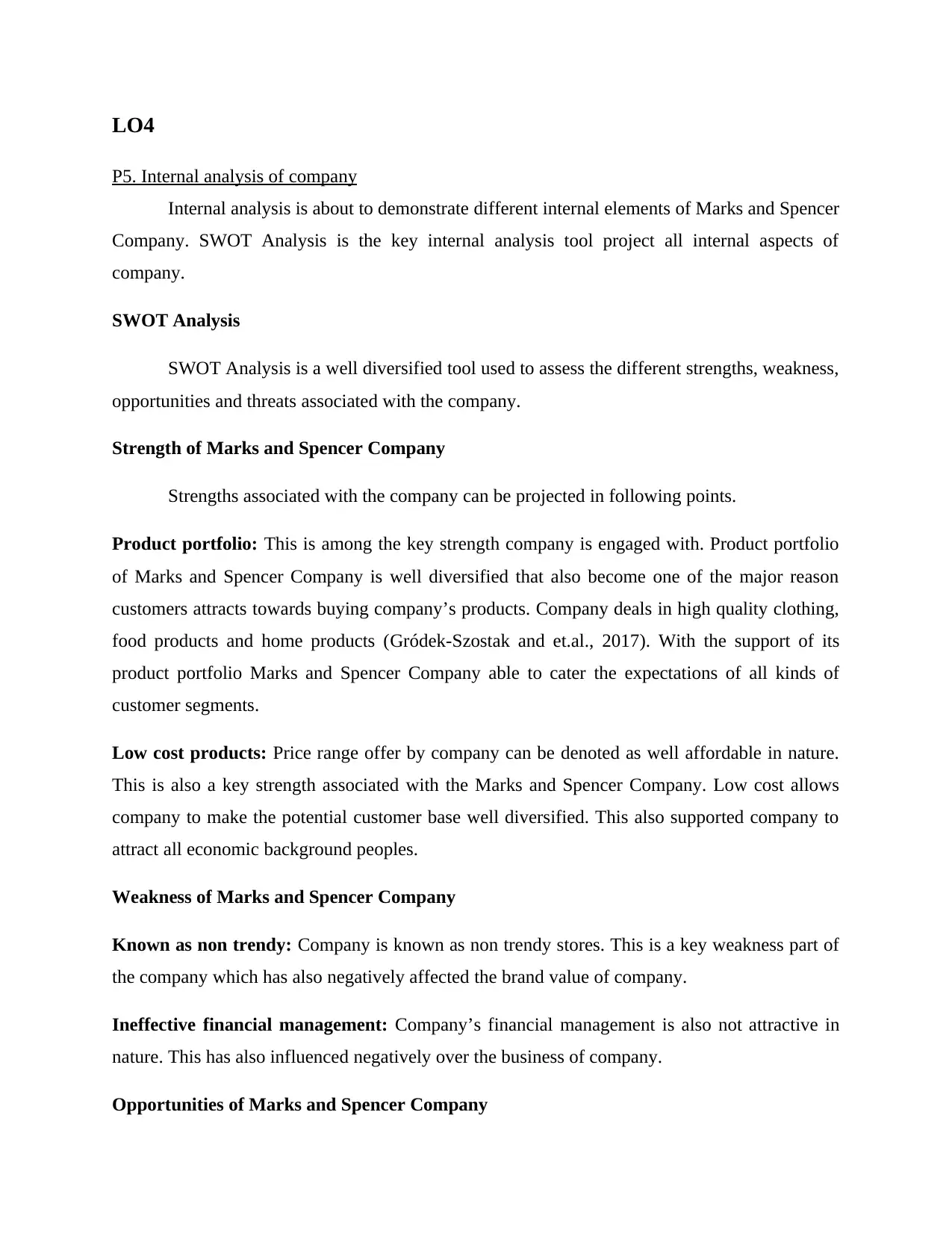
LO4
P5. Internal analysis of company
Internal analysis is about to demonstrate different internal elements of Marks and Spencer
Company. SWOT Analysis is the key internal analysis tool project all internal aspects of
company.
SWOT Analysis
SWOT Analysis is a well diversified tool used to assess the different strengths, weakness,
opportunities and threats associated with the company.
Strength of Marks and Spencer Company
Strengths associated with the company can be projected in following points.
Product portfolio: This is among the key strength company is engaged with. Product portfolio
of Marks and Spencer Company is well diversified that also become one of the major reason
customers attracts towards buying company’s products. Company deals in high quality clothing,
food products and home products (Gródek-Szostak and et.al., 2017). With the support of its
product portfolio Marks and Spencer Company able to cater the expectations of all kinds of
customer segments.
Low cost products: Price range offer by company can be denoted as well affordable in nature.
This is also a key strength associated with the Marks and Spencer Company. Low cost allows
company to make the potential customer base well diversified. This also supported company to
attract all economic background peoples.
Weakness of Marks and Spencer Company
Known as non trendy: Company is known as non trendy stores. This is a key weakness part of
the company which has also negatively affected the brand value of company.
Ineffective financial management: Company’s financial management is also not attractive in
nature. This has also influenced negatively over the business of company.
Opportunities of Marks and Spencer Company
P5. Internal analysis of company
Internal analysis is about to demonstrate different internal elements of Marks and Spencer
Company. SWOT Analysis is the key internal analysis tool project all internal aspects of
company.
SWOT Analysis
SWOT Analysis is a well diversified tool used to assess the different strengths, weakness,
opportunities and threats associated with the company.
Strength of Marks and Spencer Company
Strengths associated with the company can be projected in following points.
Product portfolio: This is among the key strength company is engaged with. Product portfolio
of Marks and Spencer Company is well diversified that also become one of the major reason
customers attracts towards buying company’s products. Company deals in high quality clothing,
food products and home products (Gródek-Szostak and et.al., 2017). With the support of its
product portfolio Marks and Spencer Company able to cater the expectations of all kinds of
customer segments.
Low cost products: Price range offer by company can be denoted as well affordable in nature.
This is also a key strength associated with the Marks and Spencer Company. Low cost allows
company to make the potential customer base well diversified. This also supported company to
attract all economic background peoples.
Weakness of Marks and Spencer Company
Known as non trendy: Company is known as non trendy stores. This is a key weakness part of
the company which has also negatively affected the brand value of company.
Ineffective financial management: Company’s financial management is also not attractive in
nature. This has also influenced negatively over the business of company.
Opportunities of Marks and Spencer Company
⊘ This is a preview!⊘
Do you want full access?
Subscribe today to unlock all pages.

Trusted by 1+ million students worldwide
1 out of 17
Related Documents
Your All-in-One AI-Powered Toolkit for Academic Success.
+13062052269
info@desklib.com
Available 24*7 on WhatsApp / Email
![[object Object]](/_next/static/media/star-bottom.7253800d.svg)
Unlock your academic potential
Copyright © 2020–2025 A2Z Services. All Rights Reserved. Developed and managed by ZUCOL.





